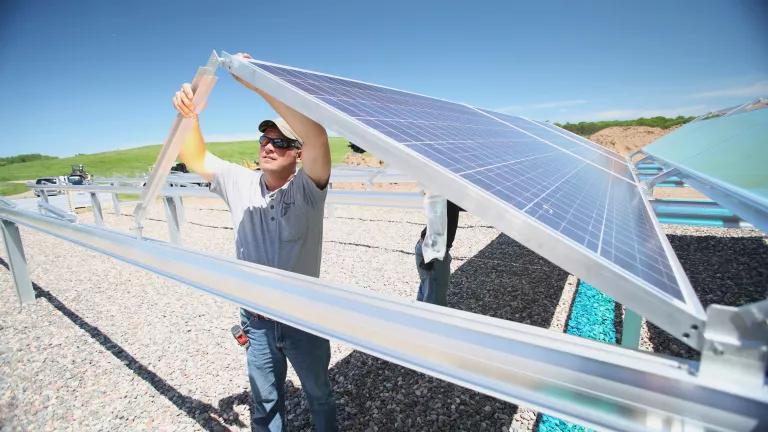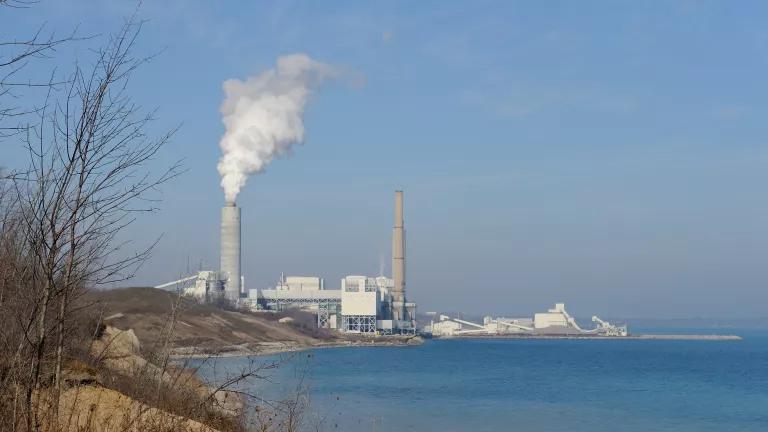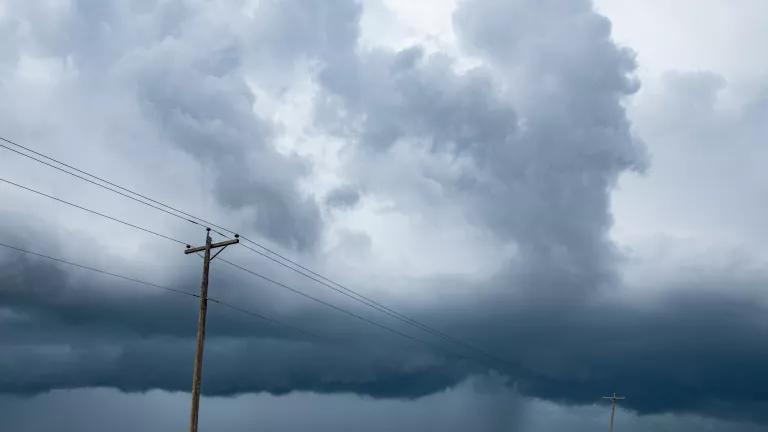Midwest States Need a Modern Grid to Supercharge Clean Energy Goals
Midwest states are already leading on clean energy, but achieving their goals depends on the power grid's readiness. We need the electricity system to catch up.

Workers install solar panels at a closed landfill in Minnesota, where Governor Walz recently signed 100% clean electricity legislation.
MPCA Photos via Flicker, CC BY-NC 2.0
The clean energy transition is at inflection point, and Midwest states are paving the way toward a clean energy future. Renewable energy is cheaper than burning fossil fuels, and federal support under President Biden’s clean energy law is driving more investment in wind and solar resources than ever. Minnesota and Illinois recently enacted legislation shifting their power sectors to 100 percent carbon-free electricity in the next few decades. Governor Whitmer of Michigan issued an executive order to make the state carbon neutral by 2050, and the state legislature is considering increasing the renewable portfolio standard. But our grid is years behind the curve, threatening to hold up the clean energy transition and limit the benefits—cleaner air to breathe, new jobs, and cheaper power—that Midwesterners are counting on.
Midwest grid operators have a lengthy to do list to align the grid with a clean energy future, and we cannot afford to continue at a snail’s pace. Delays in transmission planning and interconnection impede the integration of renewable resources that could help customers save money and keep the grid reliable.
Grid shortcomings delay Midwest clean energy progress
The outdated grid is incompatible with the rapid acceleration of wind, solar, and battery storage. This misalignment is a dangerous barrier to ensuring that Midwest states can deliver more clean energy and improve air quality, create a safer climate, and help the lights stay on during extreme weather.
Our transmission system is desperately in need of upgrades and expansion to connect new renewables to where the electricity is needed. We need a bigger grid with more higher capacity transmission lines to incorporate all the clean energy coming our way. And our aging, creaky grid infrastructure is increasingly vulnerable to severe storms or extreme temperatures when electricity demand is often at its peak. A stronger transmission system will also bring reliability benefits by lowering the risk of power outages.
For much of the Midwest, clean energy progress hinges on the Midcontinent Independent System Operator (MISO), which manages the electric grid for 45 million people across 15 U.S. states, from Louisiana to Minnesota. Despite Midwest utilities and states going big on renewable energy, the MISO region is still over 70 percent fossil fuel generation—because the grid is anachronistic.
MISO is taking steps—but the footfalls must come faster
To understand the urgent need to upgrade and expand the grid, look no further than the interconnection backlog to bring new power online. In 2022, 956 projects representing 171 GW of generation—a record number more than double the 2021 volume—submitted interconnection requests in the MISO region. More than 96% of those projects are renewable or storage resources—enough to power over 114 million homes. MISO introduced a faster process to move projects through the queue, but that is not enough. Most of the interconnection holdups in MISO are due to insufficient grid capacity. In other words, clean energy projects need more transmission lines to connect to.
MISO has been recognized for planning for future scenarios with renewable energy as the dominant power source. Last July, the grid operator approved a historic investment in transmission known as Tranche 1 that will deliver over $37 billion in benefits across the Midwest in the first of a four-part investment. But these grid fixes were long overdue and addressed longstanding reliability concerns—and took 11 years to plan and approve.
Midwest clean energy leaders need more action from MISO
Grid operators like MISO need to act swiftly on major grid upgrades, improvements to grid management systems, and a massive transmission buildout—not only to deliver on the promise of clean energy for consumers but also for grid reliability. Midwest states should ensure that MISO does the following to unlock their clean energy goals:
1. Build more transmission across MISO and between MISO and its neighbors.
MISO and MISO states need to get their planned transmission approved and online fast. It is critical that MISO and Midwest states and their utility regulators ensure Tranche 1 lines get built on time by 2030, while ensuring the remaining three parts move forward quickly. MISO is currently planning for the next portion of transmission additions, Tranche 2. MISO should approve those by mid-2024 as planned and then prioritize swift approval of Tranches 3 and 4. After MISO approval, these new lines need to be approved by the states where they will be built and then ultimately, they must be constructed. MISO and Midwest states need to look for ways to accelerate transmission development for consumers to benefit sooner from the cheap, clean energy resources and the improved reliability a modern grid enables.
MISO must push forward to get all four tranches approved swiftly for grid reliability and connecting clean energy projects already waiting in the interconnection queue, and it also needs to have plan for what comes after Tranche 4. MISO must continue a regular and robust regional transmission planning process to keep pace with the exponential growth of clean energy. In addition to grid upgrades and increasing regional transmission, MISO also needs to prioritize connecting with our neighbors so we can improve our ability to share power across regions, especially during emergency events.
2. Address the threat that more extreme weather—and unreliable fossil fuels—pose to the grid.
Burning fossil fuels contributes to the increased frequency of extreme weather. Extreme weather events stress the grid—and expose the myth of fossil fuel reliability.
MISO should prioritize incorporating more clean energy onto the grid, building interregional transmission between MISO and neighboring grid systems, and allowing new technologies like energy storage to shore up the grid. It’s not the time for business as usual at MISO. And it’s definitely not time to prop up unreliable fossil fuels.

Minnesota legislators and clean energy advocates celebrate as Governor Walz signs 100 percent clean electricity legislation into law on February 7, 2023. (Photo: 100% Campaign)
Midwest states are leading boldly on renewable energy, and we need grid operators to ensure the grid is up to the task in 2023—and 2050. With so much at stake for Midwesterners, MISO must pick up the pace to support the region’s move into a clean energy future. The clean energy leadership of governors, legislatures, and regulators in the Midwest could bring health, climate, and economic benefits, and a more reliable, resilient power system during heat waves or winter storms. But only if grid operators like MISO can step up and deliver the grid we need to make it all possible.


